
Brown Snake
Latin name: Storeria victa
Size: 9 to 13 inches
Venomous: No
You may encounter the northern brown snake, now commonly just known as the brown snake, in eastern areas of New York, as well as in the surrounding regions of Finger Lakes. The non-venomous and generally non-aggressive species is quite elusive and shy, and it’s a nocturnal one, so there's a chance you could have these right in your own back yard without ever knowing. That would be a good thing, too: they feast on slugs, snails, and earthworms, as well as other insects that would decimate plants or crops.
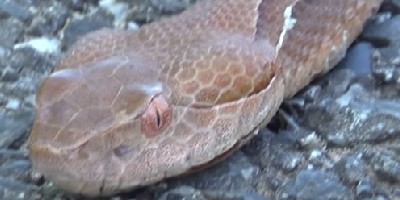 Northern Copperhead
Northern Copperhead
Latin name:
Agkistrodon contortrix mokasen
Size:
25 to 40 inches
Venomous:
Yes
The northern copperhead was now known [by experts] as the eastern copperhead in New York, but the majority of people still use the ‘old' name. This venomous snake is quite a chunky one, with several color variations, and it inhabits a wide variety of habitats, adapting to the region it is in. Generally, it likes forested areas — varied woodlands, deciduous forests, etc; but it is also commonly spotted in swamplands, rocky ledges, and lowlands. This ambush predator is not usually known for being aggressive towards humans, although a startled snake can snap and bite, often delivering a “dry” bite with no venom. Of all pit vipers, the eastern copperhead’s venom is the least powerful.
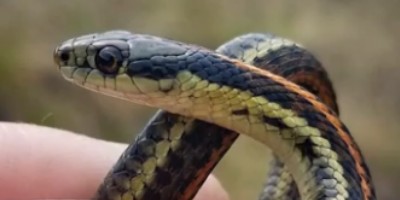 Common Garter Snake
Common Garter Snake
Latin name: Thamnophis sirtalis sirtalis
Size: 18 to 55 inches
Venomous: No
The garter snake is one of the most common snakes found in the state of New York, and it is the common (also known as eastern) subspecies that is most in abundance. In general garter snakes are very adaptable, moving from habitat-type to habitat-type with ease, and even changing up its diet to suit whatever it can find. It is more common to this snake near a body of water where it feeds on crayfish, insects, frogs, tadpoles, toads, newts, salamanders, small fish, earthworms, and much more.
Short-Headed Garter Snake
Latin name: Thamnophis brachystoma
Size: 12 to 22 inches
Venomous: No
The short-headed garter snake is one of a few different subspecies of garter snake found in New York, and, as the name suggests, the head of this snake is shorter than others. It is also much smaller than other garter snake species, with a maximum recorded length of around 22 inches — in captivity. You would need to head into the north-west part of New York in order to find this species. It spends a lot of its time burrowing underground to find earthworms and other soft-bodied insects.
Smooth Green Snake
Latin name: Opheodrys vernalis
Size: 10 to 20 inches
Venomous: No
Found in meadows, open forests, and the edges of streams and lakes, as well as other close-to-water habitats, the smooth green snake is just as the name would suggest: a bright green shade. Living in longer grass, such as meadows and fields, means that it has camouflage on its side, helping when the snake is active during the day, during the warmer months. This species is not known to be aggressive, would much rather flee than fight, and also secretes a musky-scented fluid when it feels threatened or attacked, to try and ward off predators.
Eastern Hog-Nosed Snake
Latin name:Heterodon platirhinos
Size: 15 to 42 inches
Venomous: No (Yes, but it doesn't affect humans)
This species of snake is found in more than thirty different states in the US, and even as far out as Ontario in Canada. A diurnal snake that is active most during the day, and especially around the middle of the day, the eastern hog-nosed snake can swim but doesn’t spend a lot of its time in the water. Instead, it slithers around in grasslands and savannas as well as other, well-drained, open spaces, or in pine and other hardwood woodlands. Also known as the deaf adder or the spreading adder, as well as different names in other states, the end of the nose is upturned, just like that of a hog, giving the species its name.
Eastern Massasauga
Latin name: Sistrurus catenatus
Size: 24 to 30 inches
Venomous: Yes
You may encounter the venomous eastern massasauga snake in western and central counties in the state of New York, in marshy or boggy areas. The snake is a mostly docile one, and doesn’t frequently bite humans, but it will act very defensively if it feels like it is going to come under attack. Fortunately, the teeth are quite small and struggle to penetrate through layers of clothing, so most bites are relatively harmless. It much prefers to eat rodents and small mammals to humans, anyway!
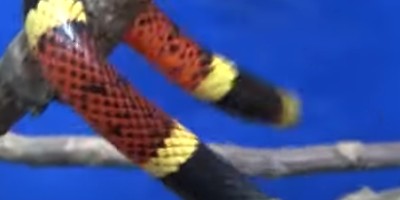 Eastern Milk Snake
Eastern Milk Snake
Latin name: Lampropeltis triangulum triangulum
Size: 24 to 36 inches
Venomous: No
The eastern milk snake is a pale gray, white, or tan colored snake with large brown or red patches that run down the length of the body. Juveniles tend to be more red in color and adults more brown, but a wide variation of shades have been reported and photographed. It is unusual to see this snake out during the day, but if you turn over rocks or logs in field edges or rocky hillsides, you might unearth one. Occasionally, you may be able to spot one attempting to cross the road, or as roadkill.
Northern Black Racer
Latin name: Coluber constrictor constrictor
Size: 35 to 75 inches
Venomous: No
The northern black racer, as the name might imply, is a dark snake, usually black, that speeds away quickly when it senses predators are close by. The scales are very glossy, almost wet-looking, and occasionally tones of brown or even dark indigo blue. Although a fast snake, it is a sedentary species, much preferring to bask in fields and other open areas, or the edges of woodlands where the tree growth helps to offer some protection. Although this snake feeds on many prey items, such as frogs, other snakes, turtles, squirrels, and rodents, it also has a number of predators itself, such as coyotes, birds of prey, domestic/stray cats and dogs.
Northern Red-Bellied Snake
Latin name: Storeria occipitomaculata
Size: 8 to 16 inches
Venomous: No
There are various subspecies of the red-bellied snake, but it is often quite difficult for novice snake watchers to distinguish between them. Interbreeding has meant that colors and patterns of this snake can vary greatly, too. Usually, the body of the snake is rust-red or brown, with stripes of a lighter shade. Some specimens can be black instead of the red/brown, and others have no stripes at all. Often inhabiting woodlands, such as deciduous and pine forests, the best environment for this serpent is one that is moist, but not too wet, and cool. Plenty of ground protection is also important — rocks, logs, leaves, etc., for the snake to hide under.
Queen Snake
Latin name: Regina septemvittata
Size: 13 to 30 inches
Venomous: No
The queen snake is a semi-aquatic species, living in bodies of moving water that is both fresh and filled with plenty of crayfish for it to eat. This species is quite an outgoing one, not as shy or secretive as other water snakes. At night, it is not uncommon to see a queen snake slithering away from its watery habitat and venturing further into dryer pastures. The larger the queen snake, the higher the chance of it being a female, but there is little to differentiate between juveniles and adults; their colorings and markings do not change as much as other snakes as they age.
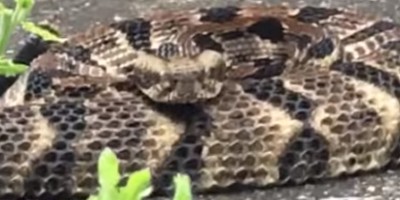 Timber Rattlesnake
Timber Rattlesnake
Latin name: Crotalus horridus
Size: 36 to 60 inches
Venomous: Yes
You may know the timber rattlesnake as the banded rattlesnake, or the canebrake rattlesnake, but it is a pit viper, venomous, and the third largest venomous snake found across North America. Growing to up to 60 inches, and sometimes even longer, this snake prefers rugged terrain, with boulders and rocks giving it protection during the very hot sun, and also from predators. You will also find them in hardwood and deciduous forests and, during the summer, in wide, open spaces, such as rocky ledges, basking in the sun.
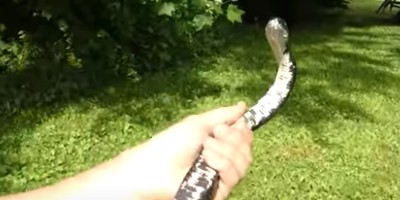 Eastern Rat Snake
Eastern Rat Snake
Latin name: Pantherophis alleghaniensis
Size: 36 to 72 inches
Venomous: No
You may encounter the eastern rat snake, also known as the chicken snake, black rat snake, and pilot snake, in southeastern areas of New York, living in a wide variety of habitats. Farmlands and other agricultural areas are quite popular, especially where there are high populations of rats and mice. These rodents make up the bulk of this snake's diet, although, as the “chicken snake” nickname might suggest, it's not averse to chickens and other birds, their eggs, frogs, lizards, and other small animals. Although not an aquatic snake, the eastern rat snake is an excellent swimmer, and it can also climb very well and is known to spend time up in trees.
Northern Ribbon Snake
Latin name: Thamnophis sauritus septentrionalis
Size: 18 to 26 inches
Venomous: No
At first glance, you would be forgiven for confusing this snake with a number of other species of garter snakes and other, similar snakes. The northern ribbon snake is often more slender than other subspecies, however, and it tends to have three stripes — one running down the back and one running down each side. Often found in areas in or around water, such as swamps, marshes, lakes, ponds, rivers and streams, it is an excellent swimmer, but doesn’t spend all of its time in the water. There, it finds food: small fish, frogs and tadpoles, toads, salamanders, newts, and insects.
Northern Ring-Necked Snake
Latin name: Diadophis punctatus edwardsii
Size: 10 to 15 inches
Venomous: (Yes, but it doesn't affect humans)
Also known as the red-belly snake, baby king snake, fodder snake, and common ring-necked snake, the northern ring-necked snake is a small, slender, and semi-aquatic species that can be found in or around bodies of water across New York. A non-aggressive species that has more bark than it does bite, it can sometimes deploy a foul-scented fluid from its anal glands when threatened or handled, and is very slow to bite. This snake is mildly venomous, but the snake finds it difficult to inject into humans, with rear-facing fangs, and the venom only usually affects people who have allergies.
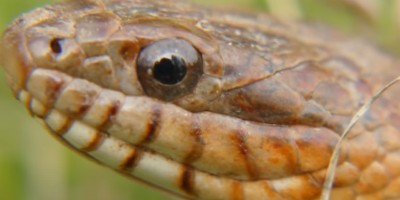 Northern Water Snake
Northern Water Snake
Latin name: Nerodia sipedon
Size: 20 to 55 inches
Venomous: No
Although it looks a little like a rattlesnake, this semi-aquatic species is non-venomous, although it can be aggressive when threatened, cornered, or startled. It inhabits a wide range of freshwater bodies — streams, lakes, ponds, and rivers. It also eats a wide variety of food — dead animals in the water, crayfish, fish, other snakes, toads and frogs, tadpoles, insects, and salamanders, along with land mammals (rats and mice) and birds. Northern water snakes are normally dark in color — gray, black, or dark brown. They are also patterned with dark blotches, looking somewhat band-like in nature. The underside of the snake is a lot paler, often white or cream, with darker small patterns around the edges.
Eastern Worm Snake
Latin name: Carphophis amoenus
Size: Under 15 inches
Venomous: No
The eastern worm snake, as the name suggests, looks a little like a worm. The body is quite small, yet stout, and it's colored a very shiny pinky-brown, often with a much lighter-colored belly. Looking like a worm isn't the only reason that this species has its name, though; it also eats primarily earthworms, but will occasionally eat other kinds of foods with soft bodies, such as the larvae of insects and grubs. Being a very secretive snake, we don't know too much about it, especially in terms of its reproductive cycle. We do know that they lay eggs, and that those eggs hatch later on in the summer (usually), but we don’t know much about the mating itself.